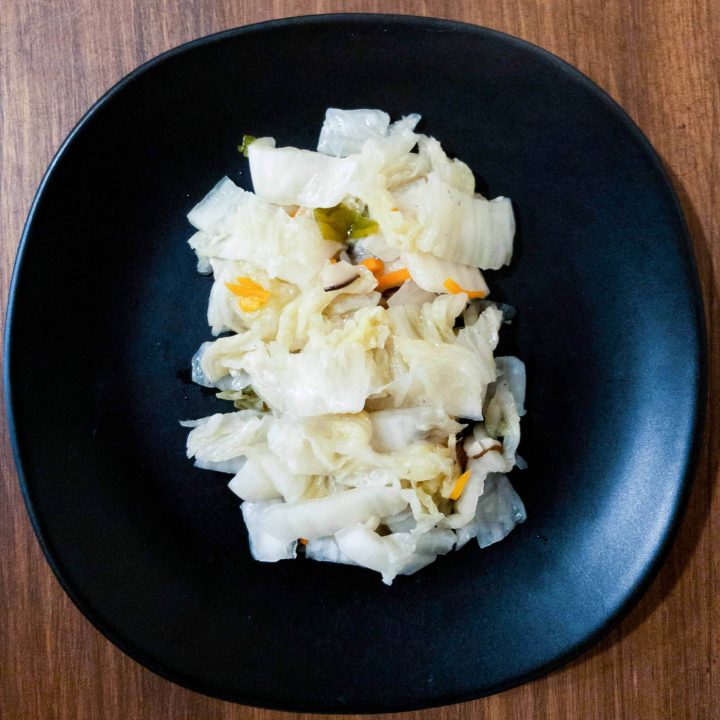Korean white kimchi (baek kimchi) is a napa cabbage kimchi that is not spicy. It has a clean and refreshing flavor. White kimchi is a variety of kimchi that is made without the chili pepper powder (gochugaru). White kimchi is usually thoroughly enjoyed by children and anyone who has issues with spicy food.
White kimchi, or baek kimchi, is really delicious and has a different flavor profile that you just have to try for yourself to understand. “Baek” means white, and “kimchi” means fermented vegetable. The best way to describe the flavor of baek kimchi is that it has a mild pickled flavor, is refreshing and crunchy.
Good bacteria
We fermented this kimchi for about two months. The longer you wait the more sour and pickled it becomes. Depending on your conditions will depend on how long you may need to ferment it for and it’s also about personal taste preference. We suggest taste testing every 2 weeks. And yes, you’re still getting all of that good bacteria for optimal gut health like you would eating traditional and spicy kimchi! If you know anyone who strays away from typical kimchi because it’s “too spicy”, make this kimchi and have them try it out. Or simply share this recipe with them! Spread the good news of a non-spicy kimchi variety that still helps to contribute to good gut health.
What to serve with white kimchi
You can treat white kimchi just like any other side dish or banchan. Have this white kimchi along with any main dish, just as you would with traditional spicy kimchi. White kimchi is delicious with Korean BBQ, such as Galbi or Bulgogi. It’s also great sliced thinly and put on top of a cold noodle bowl, like our recipe. Or, enjoy this kimchi alongside black bean sauce noodles (Jajangmyeon) or black bean sauce rice (Jajangbap)!
We really hope you enjoy this Korean White Kimchi (Baek Kimchi) recipe. It’s really tasty and adds a different flavor and variety to your kimchi collection. If you also want a more traditional/spicy kimchi recipe then make sure to check out our Easy Napa Cabbage Korean Kimchi recipe.
Want a spicy kimchi recipe?
HUNGRY FOR MORE? Subscribe to our newsletter and follow along on Facebook, Pinterest, Twitter, and Instagram for all of the latest updates.

Korean White Kimchi (Baek Kimchi)
Korean white kimchi (baek kimchi) is a napa cabbage kimchi that is not spicy. It has a clean and refreshing flavor.
Ingredients
- 1 napa cabbage (about 3-4 lbs)
- 3 green onions, chop into 1” long pieces
- 5 garlic cloves
- ½ tsp ginger root
- 4 dried Shiitake mushrooms
- 3 Medjool dates, remove pits
- 2 cups Korean turnip, sliced into matchsticks
- 1 Tbsp brined/salted shrimp
- 1 Tbsp fish sauce
- 1 Tbsp sugar
- 1 cup carrots, sliced into matchsticks
- 1 Tbsp sweet rice powder
- 1 cup salt + 2 Tbsp
- 1 cup water
Instructions
- Let’s make the porridge first. Stir the sweet rice powder into 1 cup water into a pot. Stir constantly and bring to a boil. After it starts boiling, turn off the stove burner and remove the pot from the heat and set it aside to cool.
- Rinse the napa cabbage in cold water to remove any dirt or debris. Cut each napa cabbage into quarters (length-wise). Salt napa cabbage thoroughly in each of the leaves. Let it sit in the salt for about 6 hours.
- Soak the dried shiitake mushrooms in a bowl of warm until rehydrated (about 2-3 hours). Once the mushrooms have rehydrated thoroughly, remove the stems and thinly slice the mushroom caps. Set aside for later.
- Remove the pit from the Medjool dates (if necessary) and slice thin. Set aside for later.
- Put garlic cloves, ginger root, brined shrimp, fish sauce, and the cooled porridge into a blender. Blend until a liquidy smooth consistency. Set aside for later.
- After about 6 hours, rinse the salt off the napa cabbage well. Rinse the napa cabbage about three times with cool water.
- Mix the dates, shiitake mushrooms, blended mixture, 2 Tbsp of salt, turnip, and carrots together well into a large bowl.
- Put about a spoonful of this mixture and spread it between each napa cabbage leaf. Continue until you have covered each napa cabbage leaf with this mixture.
- Put the seasoned napa cabbage in a large bowl or in a large jar and pack it gently to remove excess air as much as possible. Keep this in the fridge for about a month and a half to about two months to allow it to ferment and sour.
- Check on the kimchi periodically to check on the fermentation to eat to your liking. Enjoy!
We love seeing your creations from our recipes! Tag us on Instagram at @AsianRecipesAtHome.
Disclaimer: Under no circumstances shall this website and the author(s) be responsible for any loss or damages resulting from the reliance of the given nutritional information or ingredient/product recommendations. Recommended ingredients/products can change their formula at any time without this website and author’s awareness. It is your responsibility (the reader’s) to check the label/ingredients of any product prior to purchasing and/or using. We greatly appreciate your support and understanding.


